British Special Service Squadron - August 1924
- View news filtered by: Interwar
- View news filtered by: Navy Organisation
- View news filtered by: Specialisms
- View news filtered by: Units & Squadrons
- View news filtered by: British Special Service Squadron
- View news filtered by type: Blog

In this ongoing blog series, the National Museum of the Royal Navy is following the route of the British Special Service Squadron during the centenary of its voyage. In this entry, the core element of the Special Service Squadron comprising HMS Hood, HMS Repulse and HMAS Adelaide were visiting the east coast of Canada. The light cruiser squadron was separately sailing around South America.
At Sea: 1 August 1924
After leaving Jamaica the two battle cruisers, HMS Hood & Repulse, carried out full power trials during the late morning of Friday 1 August.
"To measure the speed, spars were thrown overboard from the Repulse at stated intervals and by noting how long the Hood took to pass these, she was able to calculate her speed. The trial lasted two hours and was watched with interest by all available hands... Her speed was found to work out at 28.2 knots, corresponding to a speed of about 32.5 miles per hour. Repulse's speed was a little over 27 knots or just over 31 miles per hour." (Wilfred Woolman, RNM 1999/31)
It took them four days to make the trip up to Halifax, Nova Scotia, Canada. They arrived on 5 August 1924 and their visit was arranged to coincide with the 175th anniversary of the founding of the city. The celebration programme included military tournaments, band concerts, pyrotechnic displays, and sporting events.
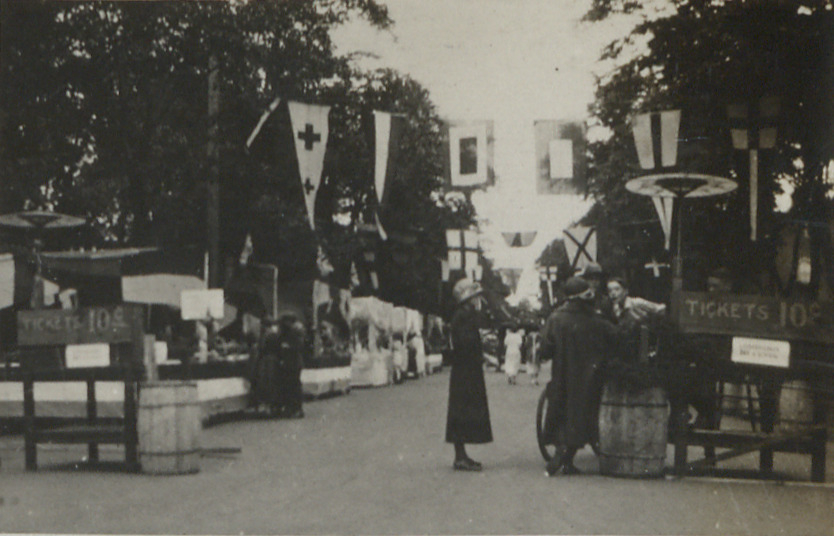
"The town is gaily beflagged in our honour and well placarded with messages of welcome. These, however, do not effectually disguise the air of poverty that hangs about the place. Beyond the main business thoroughfares, the streets are mostly unpaved, and the roads not made up except along the tramway routes. The houses are all in bad repair and do not appear to have known paint for years. The terrible explosion of the munition ship [in my opinion] in the harbour in 1917 probably has much to do with the desolate appearance of the town." (Wilfred Woolman, RNM 1999/31)
The ‘explosion’ had happened on 6 December 1917. Two ships, one of which was carrying war supplies for the First World War, including explosives, ran into each other. The explosion destroyed the north end of Halifax. About 2,000 people died, 9,000 were wounded and around 25,000 lost their homes. The Halifax explosion was the biggest human-made explosion until the atomic bomb dropped in August 1945 and memorial services are still held to commemorate the people lost and the resilience of the survivors.
The arrival of the squadron was also unfortunately marked by the death on HMAS Adelaide of one their shipwrights, Albert Scott, from New South Wales. He was buried ashore in Halifax. A further tragedy occurred on 10 August when Chief Electrical Artificer Hickman, from HMS Repulse was lost in a canoe accident with a companion, Miss Shea.
HMS Hood, Repulse and HMAS Adelaide then left Halifax 15 August 1924, travelling the 868 miles up the St Lawrence River to Quebec. While they were originally due to arrive at Quebec on 18 August, they were delayed by fog a day. When they did arrive, they were met with crowds gathered by Chateau Frontenac, the most imposing building in Quebec. The Lt Governor the Hon. Narcisse Perodeau, the Premier of Quebec (Hon L Al Taschereau), the General Officer Commander Brigadier General Landry CMG and Mr Simpson the Mayor were all there to formally welcome them.

The following day, Vice-Admiral Field and other members of the cruise, including some of the Australians from HMAS Adelaide, left for a week’s diplomatic tour to Ottawa, Toronto, and Montreal. The issue of naval deference was a sensitive point on this tour as there were several underlying issues including the status of the Royal Canadian Navy (formed from the Naval Service Act 4 May 1910) finances, national autonomy, and the Dominion’s constitutional status. The Canadian House of Commons in Ottawa had been following the cruise and had discussed Admiral Field’s speech given in Victoria, British Columbia, the previous month:
"The statement attributed to Vice Admiral Sir Frederick Field that the dominion should equip four cruisers for service - two in the Atlantic and two in the Pacific Ocean - was the subject of sharp questioning in the House of Commons. Mr A R McMaster (Liberal) asked whether Admiral Field had been asked by the [Canadian] Government to give this advice… Canada is a supporter of the League of Nations and is anxious to see naval and military expenditures minimised, that war has proved a dismal failure as a means of settling international disputes…, will the Government consider communicating [to Admiral Field]... that such pronouncements are undesirable on matters of purely Canadian national policy... The Minister of Naval Defence (Mr E.M. Macdonald) said that Admiral Field had not been invited to make the statement in the press..."Tell him to mind his own business" said Mr Roch Lanctôt (Liberal)." Otago Daily Times, 3 July 1924.
Admiral Field’s published response:
"I am not here to dictate to Canada or offer gratuitous advice on matters of policy... I will put it to you in this way: If I were a Canadian farmer, depending for my living on the overseas markets, or the head of a big commercial concern to whom foreign trade means everything, I think I should be anxious to see my trade routes adequately protected in time of war. As to what naval force such protection might entail, it seems to me that two cruisers on this coast would be valuable... They would afford protection to farmers' grain and manufacturers' products, on the way to their markets, to the point where other ships of the British Navy could pick them up." Interview with Vice-Admiral Field, The Mercury 4 July 1924.
At a formal Government dinner in Ottawa, the Canadian Prime Minister, Mr Mackenzie King, was more diplomatic. While proposing a toast to the health of Vice-Admiral Field as the principal guest, Mr King said:
"...that some people were apt to criticise Canada's navy, but that the Canadian naval service was new blood in a great naval power … If, however, a critical situation should ever arise the new blood in any department of the national life might be expected to act its part in a manner which would do credit to the whole world." The Daily News, 23 Aug 1924.
In Toronto, Vice-Admiral Field was asked to open the annual Canadian National Exhibition, known as the CNE. 150 officers and men were invited there for a week as guests and two field gun crews, one each from Hood and Repulse were included; the guns being sent with them. Two gun-crews from the Royal Canadian Navy were also guests at the exhibition and the four crews each night gave a field gun display; the team from HMS Repulse team won a silver cup for the display.
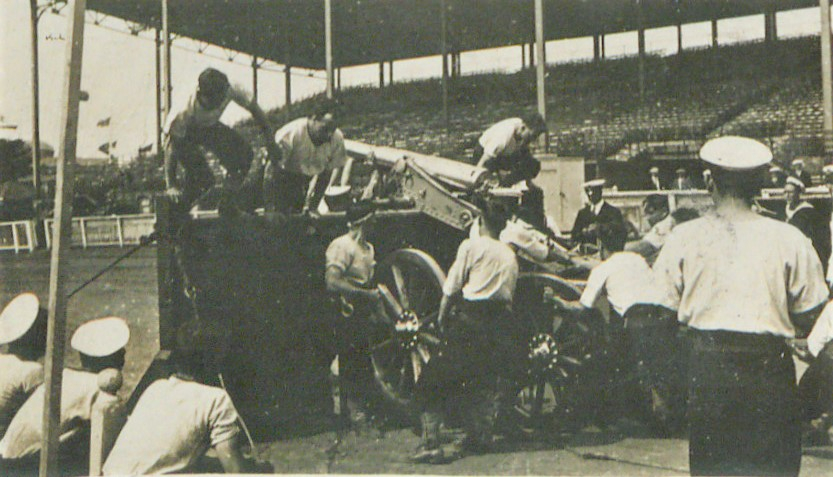
In Montreal, they were hosted by different organisations including the Harbour Commission and the Rotary Clubs. At the Rotary Club, one of the hosts, Colonel Brough, made a plea for unity within the Dominions:
"We should tell them in England that there is one thing we should do- namely, keep money in the family. Canada and Australia have not sufficient. An interchange of opinions, ideas and closer co-operation are needed." Brisbane Courier, 29 August 1924.
Quebec was one of the longest stops on the cruise, and they did not depart until 2 September 1924, heading for Newfoundland.
"Quebec... is the most interesting of all the cities in Canada... the French-Canadians... will never surrender their patrimony or change their language or religion; but they can be won to fellowship with their British co-citizens if they are treated with generosity and a just regard for their rights." O’Connor, p.262.
Light Cruiser Squadron Coquimbo, Northern Chile: 1 August 1924
Meanwhile, the light cruisers, with HMS Delhi as the flagship of Admiral Brand, arrived at Coquimbo in a very thick fog on 1 August 1924. The formalities included lunch aboard the Armada de Chile’s cruiser, Chacabuco, with HMS Delhi and HMS Danae acting as hosts in return. The British officers visited the Chilean naval ships stationed there which included the former British destroyer HMS Broke. In 1920, the ship had transferred to the Chilean Navy and been renamed the Almirante Uribe. The Chilean navy was in a high state of efficiency and their ships were well kept, impressing the British officers. The visit was only brief as they sailed the following day; HMS Delhi and Danae for Valparaíso; HMS Dauntless and Dragon for Talcahuano.
Valparaíso, on the coast of central Chile was a major port on the sailing route around South America. On arrival, HMS Delhi fired gun salutes in acknowledgement to the country and the Chilean ship Blanco Encalada returned the salute to Admiral Brand’s flag with 13 guns. The custom of gun salutes goes back before the first formal regulations for the Royal Navy in 1688. The salute both honoured the guest and confirmed a friendly approach as the guns were then empty after firing. Gun salutes are officially regulated with 21 guns for Royalty, and the rest even today is still based on the 1688 regulations, as can be seen in the table below, which allowed 19 guns for an Admiral [The following is an extract from The Queen's Regulations for the Royal Navy 2017, Ministry of Defence]
9424. Scale for Foreign Flag Officers. The following scale, in which the maritime powers generally have concurred, is to be observed in reference to the interchange of salutes between HM ships and foreign ships of war which bear the flag of a Flag Officer or the broad pennant of a Commodore or a Captain commanding a squadron or division:
| Rank | Number of Guns |
| Admiral of the Fleet or Flag Officer who ranks with a Field Marshal | 19 |
| Admiral | 17 |
| Vice-Admiral | 15 |
| Rear Admiral | 13 |
| Commodore, or Captain commanding a squadron or division | 11 |
Whilst at Valparaíso, Rear Admiral Brand, Captain Austin of HMS Danae, and a party of men, placed wreaths on the monument of Manuel Blanco Encalada and Admiral Lord Cochrane. Blanco Encalada was the first commander of the Chilean navy. The British Admiral Lord Cochrane had been dismissed from the Royal Navy in 1817. In 1818 he was invited to Chile to organize and command their navy, which he did until 1822. Rear Admiral Brand also took the train to call on the President of Chile Arturo Alessandri at the capital, Santiago on 8 August, before their departure the following day. It would have been one of President Alessandri’s last foreign engagements before a military coup occurred on 5 September 1924.
Talcahuano: 6 August 1924
HMS Dauntless and HMS Dragon were close to the principal naval base in south-central Chile planning their entry with the British consul. Messages were exchanged:
"about firing salutes & the supply of drinking water, berthing the ships & numberless other things. It all works very well when we go off with our Divisions, the Commander becomes ‘Flag Captain’, I become ‘Admiral’, Tufnell ‘Flag Lieutenant: at least I mean they do these duties in additional to their ordinary ones… I have just heard that the Admiral who lives on shore has gone on leave so all the entertaining will be done in Concepion & I shall have to call on the Intendente of Province." RNM 2015/175/4.
The town was established in 1764, based around its natural harbour, and taking its name from an Araucanian chief, Talcahueñu. The naval base then developed during the Chilean War of Independence from Spain. The crews from the light cruisers would have seen the remains of the captured Peruvian ship Huáscar (1864) now preserved as a museum ship, taken during the War of the Pacific (1879-1884) between Chile, Peru, and Bolivia.
With the regional Admiral away, the formal functions were at Concepción, eight miles from Talcahuano. Captain Round-Turner of HMS Dauntless received a letter from the Chilean Commander in Chief with a wreath since their next sailing was to pass the site of the Battle of Coronel, an engagement between the Royal Navy and German Fleet in 1914. The wreath was:
"to lay in honour of 'the brave Britishers of Admiral Cradock's squadron on the spot where the battle took place." O’Conner p.271.
At 5pm on 10 August 1924, HMS Dauntless and HMS Dragon sailed and met the First Division, HMS Delhi and HMS Danae, at sea.
At Sea: 10 August 1924 (evening)
The four light cruisers sailed close to the location of the Battle of Coronel where a memorial service was held:
"We dropped three wreathes, two of our own, and one given by the Chilean Navy, I read a special form of service… largely consisting of the Burial Service but it was dark & blowing so we only had one hymn, accompanied by the band." RNM 2015/175/4
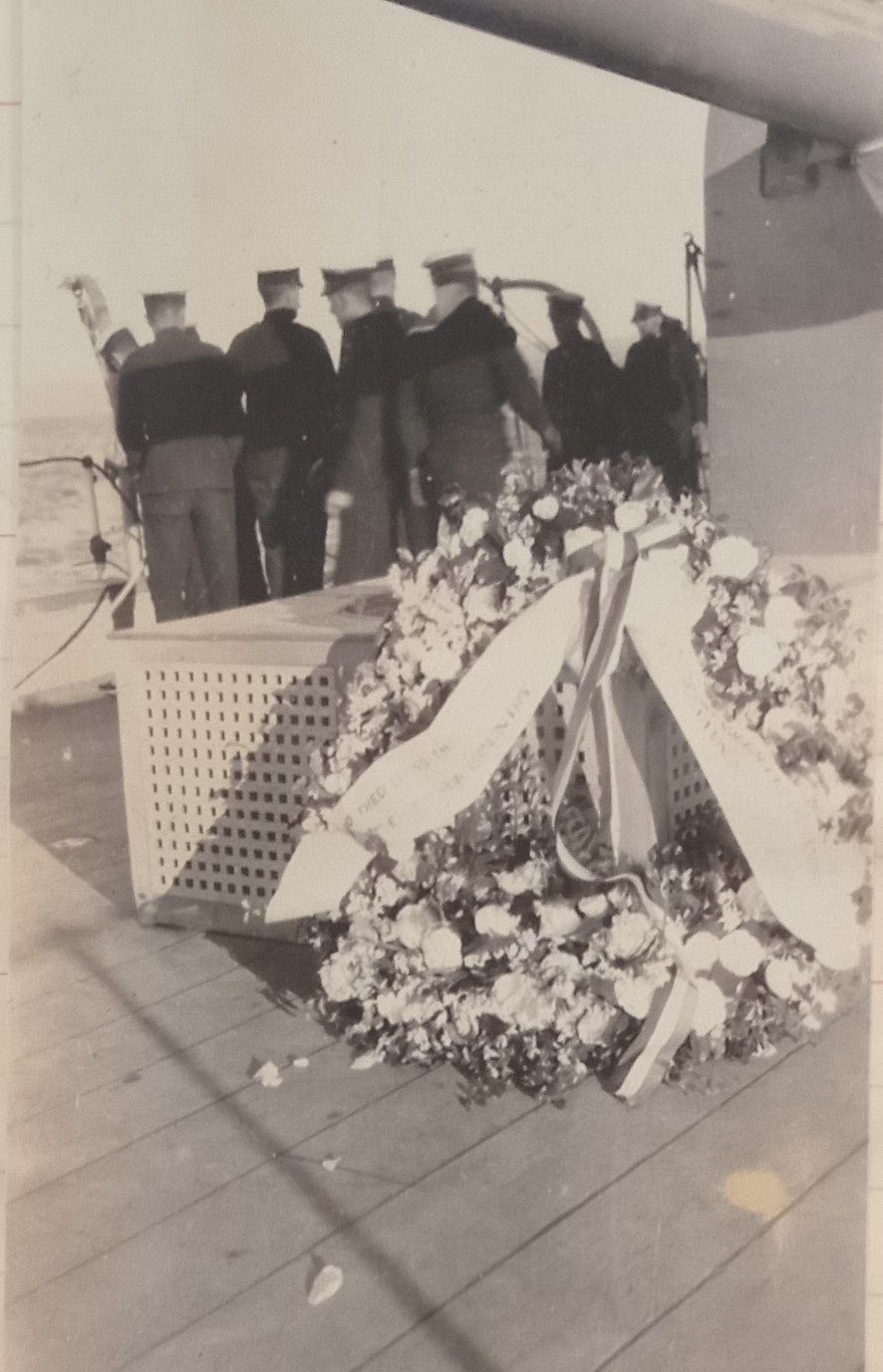
The weather was getting increasingly bad as the cruisers sailed further down the coast of South America. They had planned to visit Punta Arenas, but the weather became so bad, Rear Admiral Brand decided to abandon the visit, avoiding the Magellan Straits, and going around Cape Horn.
"It appears that weather round here really is the worst in the World as the sailing directions have it…the [HMS] Delhi is just ½ mile away abreast of us but at times when we are both in a hollow, I can only just see the Admirals flag at the top of the mast, but these ships are good… [15 August 1pm, off Cape Horn]… I don’t suppose 1% of the Navy have ever been round Cape Horn and I am already feeling rather swanky about it." RNM 2015/175/4.
As the signal came to alter course northward around the Cape about 2.30 pm, a group of men in HMS Delhi started singing ‘Rolling Home’, knowing the ship was at last heading north.
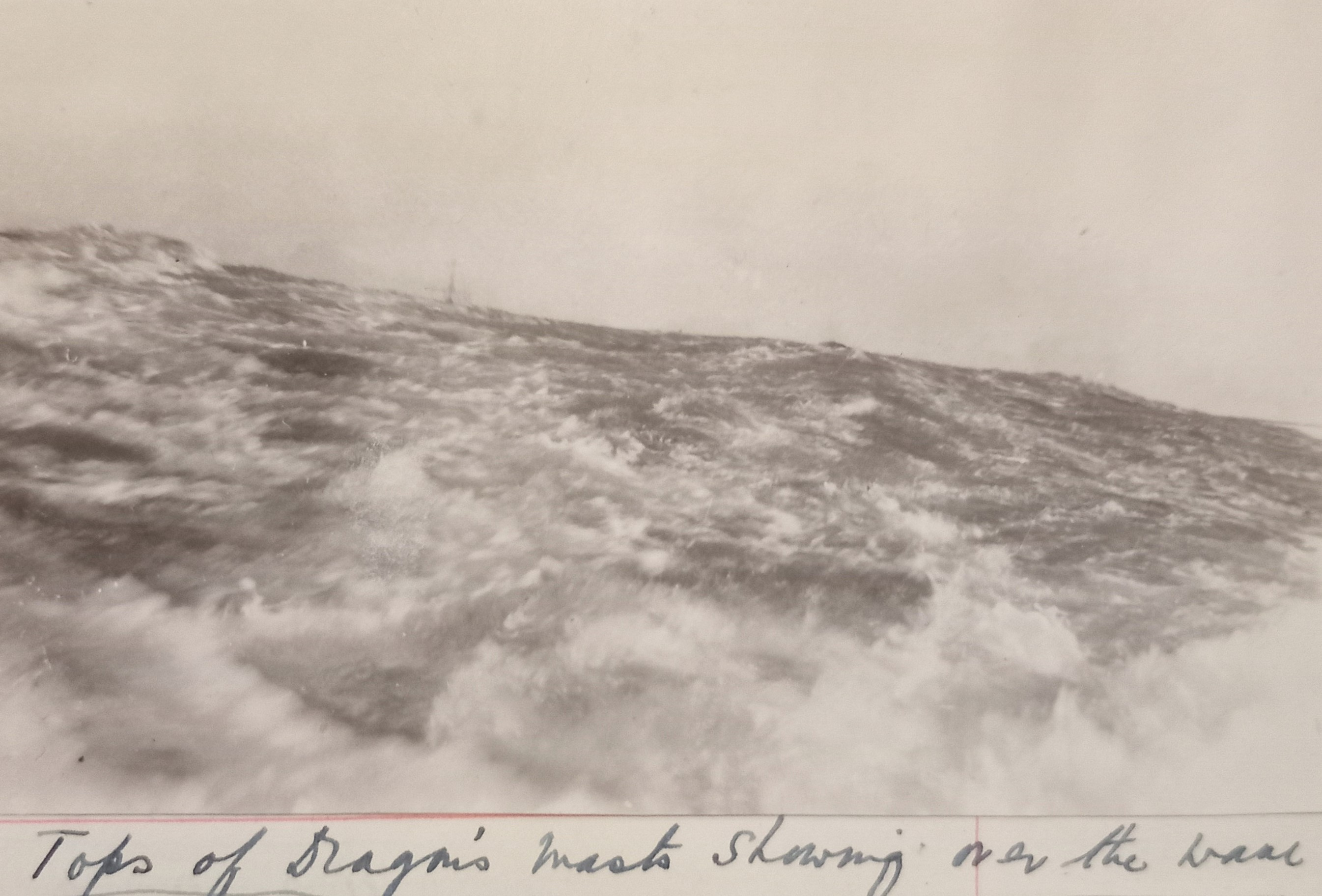
On 16 August 1924 the light cruiser squadron split again. HMS Dauntless was heading to the Falkland Islands: HMS Dragon for Bahia Blanca, the biggest grain exporting port in the Argentine, which also exported to Britain. HMS Delhi and Danae were heading up to the River Plate to Buenos Ayres, now Buenos Aires, the capital of Argentina.
Buenos Aires: 30 August 1924
HMS Delhi and HMS Danae arrived at Ensenada Roads at the estuary of the River Plate, known as Río de la Plata. They were welcomed by the city, which included a large British ex-patriot trading community, who hosted a Ball at the Plaza Hotel in honour of the visit.
A detachment of 120 men from HMS Delhi and HMS Danae formally marched through the city and placed a wreath on the monument to Almirante Brown. William Brown was an Irish sailor and the first Admiral of the Argentine Navy, or the Armada de la República Argentina (ARA), during Argentina’s war for independence from Spain. The President, accompanied by the Rear Admiral reviewed the men at the Palace after the parade.
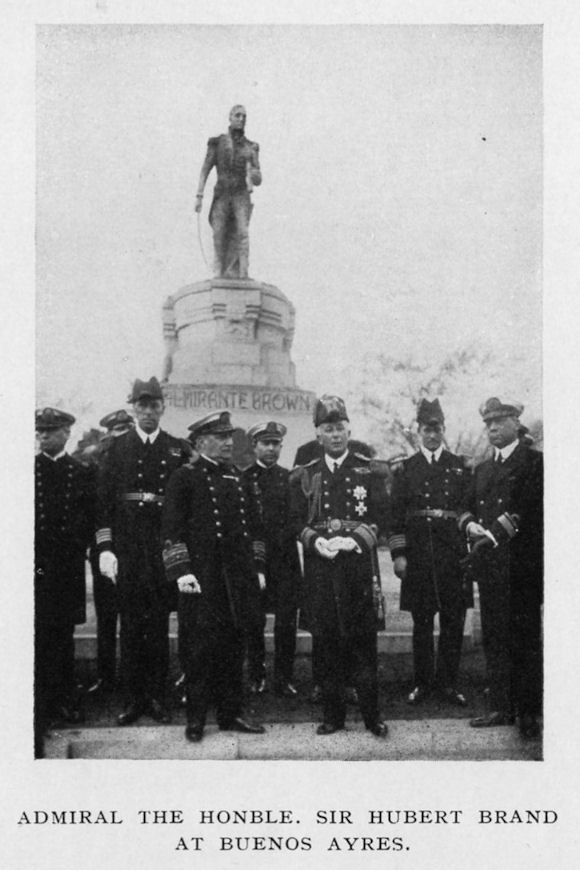
The city was also being visited by the Italian Crown Prince, Prince Umberto, who was on a tour of Italian expatriate communities in South America. Rear Admiral Brand, Captain Pipon and Captain Austin were presented to His Royal Highness on the Italian cruiser, San Giogio, on 29 August, prior to their departure.
Falkland Islands to Montevideo HMS Dauntless: 16-23 August 1924
"Falklands ended up very well… At the ball at the Town Hall… we had both our bands there, string and jazz and they played alternately. The population was so pleased, they had not heard a band for four years… our ‘At Home’ in the afternoon was a good affair… I had a good party to tea in my cabin, amongst them Mrs Roy Felton who gave the warning of the approach of the German Squadron in 1914, for which she got the O.B.E. What she did (she lived miles out in a very lonely spot) was to have her two maids keep look out from a high hill nearby, they rode up the hill, kept an hour’s watch at a time; one came galloping down one day & reported the Germans & Mrs Felton telephone the news into the town. The said maid who saw them first is now cook at Government House and she showed me with pride the silver tea pot presented to her by the Admiralty." RNM 2015/175/4.
The awards of the silver plate were confirmed 1 April 1915. The Order of the British Empire (OBE) was not instituted until 1917 so the Royal Warrants for the award including Mrs M.H Felton, were not issued until 29 August 1919. (PPL-MED-1-1, Jane Cameron National Archives).
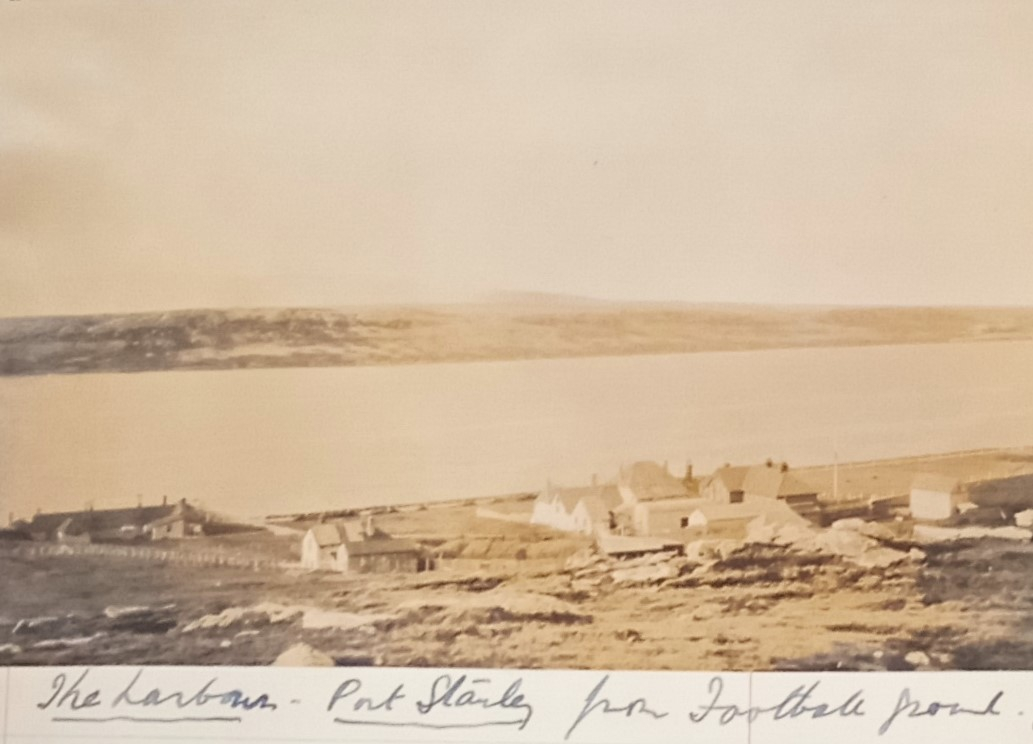
HMS Dauntless made only a short stay at the Falkland Islands before heading up to Monte Video (today Montevideo, Uruguay). On the way up the coast, they joined with HMS Dragon off Bahia Blanca and arrived at Montevideo 23 August 1924. In addition to the formal functions there was a Folly Ball, featuring popular dancehall tunes of the period.
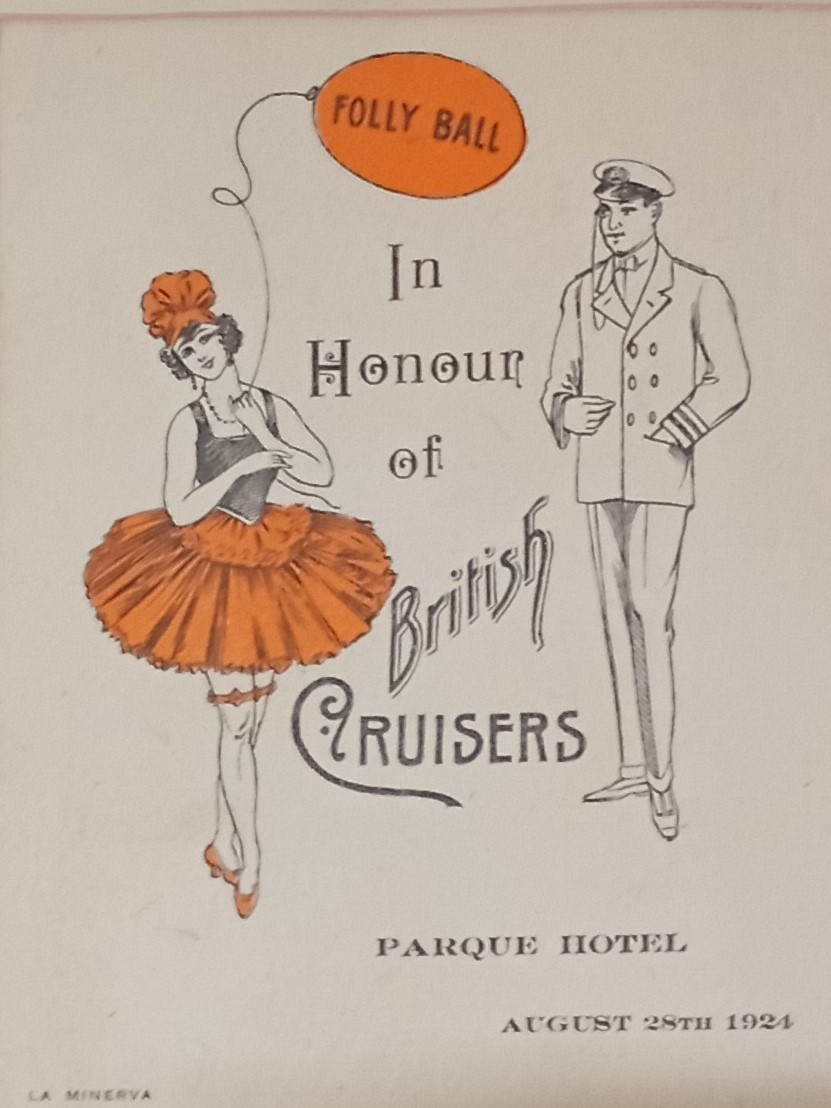
At the end of August, the cruisers left their respective ports and sailed up the coast for Rio de Janeiro, Brazil.
Come back next month to hear about the final leg of the squadron’s journey, with the battle cruiser Squadron in Newfoundland and the light cruiser squadron in Brazil before the voyage home. In the meantime, if you want to learn more about the British Special Service Squadron you can search our Collection.
Sources and further reading
A CANADIAN NAVY Admiral Field's Statement Otago Daily Times ISSUE 19214, 3 JULY 1924, PAGE 7
Awards to Mrs Felton in Files PPL-MED-1-1 and WAR-WW1-1-3 held with the Jane Cameron National Archives, Jeremy Moore Avenue, P.O. Box 579, Stanley, Falkland Islands FIQQ 1ZZ
Brisbane Courier Tour of Canada: the young Australians. (Qld. : 1864 - 1933) Australian Press Association Fri 29 Aug 1924. Page 9
Naval Defence. Ottawa. August 22. The Daily News (Perth, WA : 1882 - 1955) Sat 23 Aug 1924. p.9.
Holder, Arthur Activities of the British Community in Argentina during the Great War 1914-1919 p.10.
Mitcham, John C. The 1924 Empire Cruise and the Imagining of an Imperial Community. Britain and the World, March 2019, vo. 12, No. 1 : pp. 67-88.
The Queen's Regulations for the Royal Navy, BRd 2 - Chapter 94, Command of the Defence Council; published by Navy Publications and Graphics Organisation (NPGO) April 2017. Retrieved 13 July 2024
The Mercury (Hobart, Tas.: 1860 - 1954) Friday 4 Jul 1924. Page 6 Interview with Vice-Admiral Field.
RMM 1982/87a/306, the album of Royal Marine, M.L. Lewis.
RNM 2015/175/4, Letters of Captain Charles Round-Turner to his wife. 1923-1924.
RNM 1999/31, Woolman, Wilfred. Typescript transcription of a diary kept by Wilfred as Schoolmaster in HMS Repulse during the world cruise of the Special Service Squadron, 27th November 1923 - 29th September 1924. Transcript by his son Aubrey Woolman.
Scott O'Connor, Vincent Clarence. The Empire Cruise. Riddle, Smith & Duffus, 1925.
Vivian, John. The Empire Cruise published in The RUSI Journal, 1926.